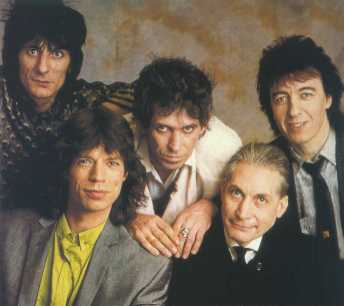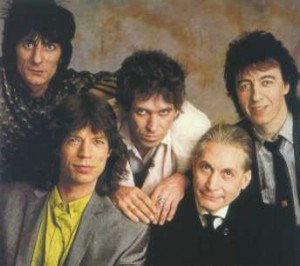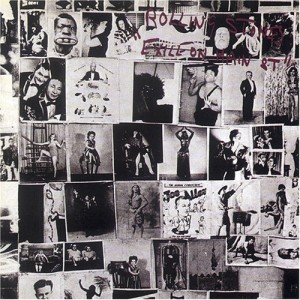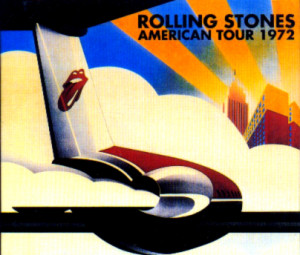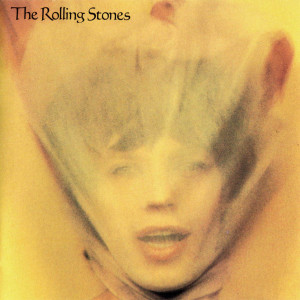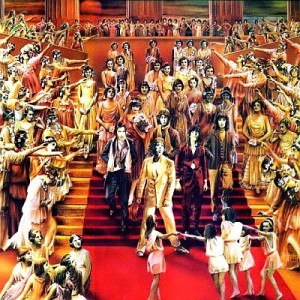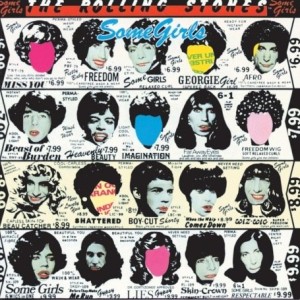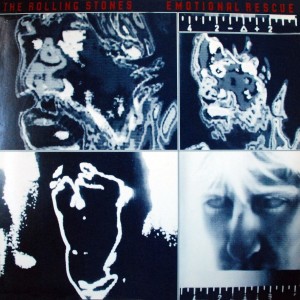Yeah, yeah, I’ve kept you waiting for this, the fourth part of my potted travail through the history of the Rolling Stones, on their 50th anniversary. Feel outraged or elated at the events, albums and singles I’ve put in or left out of my exhaustive list – feel free to comment or spark a debate. Starting with Exile On Main Street and ending with the best pruning, peacocking rock ‘n roll single of the 80s, Start Me Up, this next set of choice picks marks one of the bands most dry-periods, one in which the quality fizzles out and the hits start to wane.
31. Exile on Main Street, Rivera ‘s Sunset Strip style.
Moving ‘en masse’ to the south of France, The Rolling Stones left the UK for tax purposes in the spring of 1971. Turning their back on “dear old Blighty” and the unfavorable “83%, rising to 98% tax on unearned income”, the band members scattered themselves liberally, from St. Tropez to Vaucluse. Despite his predilection for heroin, Keith Richards remained the driving force behind the bands next album, Exile On Main St. – so named for its’ non-specific but universally generic allusion that every city in the USA had one.
His decadent Nellcôte Chateau would become the main hub for the album’s recording – though a number of tracks are saved from previous sessions at various times, including those laid-down at the Sunset Studio in L.A during 1969 – after a fruitless search in Cannes and Nice for suitable facilities failed to offer any viable solutions. Using the groups recently purchased Mighty Mobile eight-track unit, Richards persuaded his compatriots to use his extravagant, Villefranche Bay, pile and its’ labyrinth of rooms and corridors in the basement to experiment with both resonance and acoustics; which at times gives the album a disconnected vibe, as each musical part bleeds or drifts into a cyclonic whirl – for the most part this method works quite well.
If Sticky Fingers was, in part, imbued with the diaphanous acid-country of Gram Parsons than Exile owes homage to the rousing gospel liturgy-like performances of Billy Preston. Turned-on to Preston’s reverence by The Beatles, who brought the celebrated organ and piano player to ease the tension during their break-up album, Let It Be, the Stones produced their most sagacious spiritual opus.
Beset by the usual traumas and lack of cohesion, Mick Jagger and Richards grew even further apart. Recently married to his Nicaraguan beauty, Bianca, Jagger was perusing with the intellectual and arty elite in Paris whilst his erstwhile musical partner was caught-up in various drug-related scrapes and japers. Yet Richards went through one of his most creative epiphanies as the bands helmsman, steering them through those turbulent times. He even got to sing lead on his horn-blasting paean, Happy.
Swelling to a double album, Exile is an exhaustive travail that encapsulates every facet of the Stones sound to date; paying tribute to the blues, Stax soul, country, bluegrass and “Honky Tonk” bawdry rock and roll. Languorous and, even, lumbering throughout, the LP exudes a tone of free-spirited looseness. Perhaps the most popular track, Tumbling Dice, is a case in point with its’ laid-back demeanour and ‘boogie woogie rocking and a reeling’ meandrous rhythms. Originally recorded years before under the title of Good Time Woman, and destined for Sticky Fingers, its’ reformation suited Exile better.
Arguably in his element, Jagger’s rubber-necked pouts and ‘down south’ Orleans’ twang swaggers over a bounty of both heralded brass (Casino Boogie, Loving Cup, Rocks Off) and gospel “yeah-yeah” (I Just Want To See His Face, Soul Survivor, Shine A Light), all complimented by a choice chorus of hallowed backing singers – which included Dr.John on the beatific folk balled turned “praise be” eulogy, Let It Loose.
Those usual themes of the romanticized America of yore permeate, with the guaranteed cast of miscreants, losers in love, gamblers, vagabonds and drug addicts. However, social and political comments are cryptically woven into many of these mythic narratives, with the old country and blues feel of Sweet Black Angel alluding to the activist, reformer, and member of Communist Party USA, Angela Davis who had been implicated and arrested for her part in the fateful and tragic Marian County Courthouse Incident, in which the 17-year old African American student Jonathan Jackson took control of a courtroom and armed the black defendants that were on trail and took the judge and three female jurors hostage. A subsequent escape ended in a number of fatalities of both sides. Davis was accused of supplying the weapons involved (true she owned the sawn-off shotgun), and due to the laws of “implication and by association” in the US a warrant was issued for her arrest. On the run for a while, Davis appeared on the FBI’s most wanted list. She was eventually tried in 1970 and give a rough ride; finally imprisoned but cleared of all charges two –years later when a huge outcry helped to quash her conviction.
Passing between the moods of an Alabama church service and ‘Basement Tapes’ ala The Band and Dylan, Exile On Main St. marked the Stones nadir; with, apart from Goats head Soup, every subsequent release failing to match or live up to this double album. Turbulently gathered together in what should have been the height of dysfunction and failure, the band managed to knock-out one of their most revered achievements – and give Primal Scream a career off the back of it.
The unfortunate fall-out from Exile saw both Richards and his bode, Anita Pallenberg, busted for dealing heroin. And whilst the groups feigned, gilded “pirate king”, readily admits to his and Anita’s worrying habit, allegations of supplying where probably disingenuous and fatuous. Lucky to escape a lengthy jail term, the pair were banned from entering France for two-years. Richards thumbed-it to L.A, where he finished all of Exile’s mastering and production, before embarking on new adventures.
32. “Cocaine and Tequila Sunrise Tour 72.”
“The Stones’ big, ugly 1972 tour started on June 3. You can see how a sensitive person like Keith might need medication, but none of this stuff cheered me up. I hoped for better things. The idealism of the 1969 tour ended in disaster. The cynicism of the 1972 tour included Truman Capote, Terry Southern (would have included William S. Burroughs if the Saturday Review had come up with Bill’s price), Princess Lee Radziwill, and Robert Frank. Featured sideshows on the tour involved a traveling physician, hoards of dealers and groupies, big-sex-and-dope scenes. I could describe for you in intimate detail the public desecrations and orgies I witnesses and participated in on this tour, but once you’ve seen sufficient fettuccine on flocked velvet, hot urine pooling on deep carpets, and tidal waves of spewing sex organs, they seem to run together. So to speak. Seen one, you seen ‘em all. The variations are trivial.”
Stanly Booth, Keith: Standing in the Shadows.
Maybe stretching the exuberance and indulgences a little far, nonetheless the respected music writer, Stanly Booth conveyed and summarized the apodictic debauchery of the Stones in 1972.
Their “S.T.P’ tour (Stones Touring Party) was indeed glutinous and like something from the last days of Sodom & Gomorrah; an inter-state rollercoaster of live dates in which the band hardly steeped out of the limo, hotel and venue to take in their surroundings.
The prelude or benchmark for all subsequent big business and mythical rock ‘n roll tours, this caravan of friends, hangers-on, lawyers, doctors, celebrities and counter-culture vagrants, all climbed onboard the groups juggernaut of excess. Christ! They even had the ultimate status symbol of pomposity and flamboyance…the private jet!
The effete age had began, their musical direction and agenda poised and aimed at the repetitive mantra of fun, fun, fun!
33. Goats Head Soup, recipe for distraction.
As the first Rolling Stones tenure drew to a close and a new epoch approached, the now appellate “Greatest Rock ‘n Roll band in the world” could look back proudly on a fruitful career – despite the smack, in-fighting and tragedies of course. From 1962 to 72 they’d released ten, mostly, omnivorous and stunning albums and a staggering forty-five singles; many of which didn’t appear on the albums.
Their next stormy chapter would mark the end of their most productive period.
Sounding like a playful allusion to Satanism (again!) or a sub-Saharan delicacy, Goats Head Soup is a strange heady brew that has more in common with Beggars Banquet and Let It Bleed than with their last magnum opus, Exile On Main St.
In an exile funk, arguably of his own making, Richards’ options of residency were limited. Booted-out of France, non-grata for tax purposes in the UK, and out-staying his welcome in the States, it was either the “yodel-leh-hee!” skiing ranges and mountains of Switzerland or…the pleasurable oasis of Jamaica. Yep, Richards and his debacle settled in that winter of 72 upon the island, setting up base at Kingston’s Dynamic Sound Studio.
Remarkably, the evident aroma of the local intoxicates didn’t seem to upset the bands flow; if anything they wrote and recorded far too many tracks. The old magic returned as Jagger settled down and began strumming the opening chords of the Gram Parsons-esque Winter; a number first conceived during sessions for Sticky Fingers.
Hustling that now synonymous Louisiana drawl and salacious swagger, the album opens with a voodoo raunchy skulk across St. Louis cemetery on Dancing With Mr. D. Heard crackling and seeping through in a state of efflux, the chiming funk-fried presence of Billy Preston can be heard playing the clavinet on both this nod to mortality and the rest of the LP.
Recalled for a second time, alongside Richards’s right-hand sax man and friend Bobby Keys, he joined an exotic mix of percussionists to add a certain reverent tone and mood that sways between the reflective beguilement of 100 Years Ago, and the “urban R&B” Doo Doo Doo Doo Doo (Heartbreaker); a song in which Jagger interweaves the tall tales of a boy mistakenly shot dead by US cops, and a 10 year-old girl who dies of a drug overdose in a sleazy back alley.
34. Angie.
The saddening end of an affair, whispered, wooed and echoed in pained resonance by Jagger, whose spooky warbled vocals are a result of consciously leaving the ghost-track guide on the recording. Written and dreamt-up by Richards, Angie has been misconstrued as a tribute to his, yet unborn child, Angela, or fatuously claimed to be a reference to Bowie’s, than wife, Angie. Hell, it’s even been suggested that Richards wrote this song about the actress Angie Dickenson, though there is no evidence that the two met or enjoyed any kind of liaison.
In his recent biography, Richards laughs of any of these ideas, maintaining that the Angie of the title was a reference to his rehabilitation from heroin abuse – though he did get back on it a short time later. But then he also muses that Angie just happened to chime with the melody he composed, and that it could easily have been Diane.
35. Relax, It’s Only Rock ‘n Roll.
The basic premise of the Stones 12th album was to give their critics, especially the punctilious music writer Lester Bangs, the bird-finger salute.
Bangs’ condemnation at the paucity and profligate decline of the group was particularly scathing – quite justified in some respects – and only increased with each new release.
Incredulous at the growing derision and, as they viewed it, over-analyzing of their music, this album makes no bones about its regression back into the rock ‘n roll womb, albeit a version of that initial scene performed by a languid miscreant bunch of lolloping posers.
The self-titled track and single from, It’s Only Rock ‘n Roll (And I Like It), was strangely – so it’s claimed by Richards – conceived by a testy Jagger, and recorded with his new “soul mate” Bowie as a rough demo. Such was the internal drift between the Stones creative partnership that Jagger often composed and thrashed out ideas away from Richards. During this particular break in communications, Richards was hanging out with the Faces lead guitarist and crow-haired sporting Ronnie Wood at his London studio. Wood had begun recording a solo LP, and had asked along both Richards and Mick Taylor to add a touch of sleazy blues. Whilst at one of these relaxed sessions, Jagger dropped in and cut a version with Woods and, Small Faces/Faces drummer, Kenny Jones, but also produced another version with his comrades at a later date (Woods again played on this, contributing the rhythm guitar part on the 12-string). Regardless of who had their paws on it, It’s Only Rock ‘n Roll (And I Like It), is a stereotypical Stones pruning swaggered anthem, one that leans very heavily upon the strutting glam-rock pout of T-Rex.
Geographically separated, and as usual, saber-rattling with the establishment, the band pushed-on, even though by now Richards’s increasing drug-fueled skirmishes looked certain to scupper any attempts to successfully record.
To top it all, Taylor’s growing resentment at the lack of credit and acknowledgement for his contributions set the ball in motion for his resignation from the band a year later. Yet despite his disgruntlement, Taylor hung-on in there, playing on a majority of the albums ten-songs but not the title track single; even though he appears in the video.
Without their due-diligent and overseeing producer, Jimmy Miller, the production fell to the self-aggrandizing, “Glimmer Twins” pairing of Jagger & Richards. Miller, a stalwart member of their inner circle and sometimes sobering force for good, had finally succumbed to his drug habit (picked-up whilst working with the band) and left, leaving the pair to take control for the first time since Their Satanic Majesties Request – we all know how that turned out!
36. Fool To Cry.
Rather than head back out onto the open road to promote It’s Only Rock ‘n Roll, our effete troubadours continued to record whilst the going was good; much, as it turned out, to the exasperation of Mick Taylor who decided to call it a day.
The leading single from their back-to-back Musicland studios recorded album, Black And Blue – an LP remembered more for its initial S&M bruised and battered female model fronted campaign, than for the music -, ‘Fool To Cry’ has all the traits of a Philly soul balled, as reworked by Bowie on Young Americans.
Both this oozing sentimental number and the album had a gestation period before being released in 1976; tour commitments and the release of a compilation prolonged the wait.
During recording sessions the band auditioned a wealth of guitar talent that included Harvey Mandel (Canned Heat for a while, and John Mayall) and Wayne Perkins (Alabama session man from the Muscle Shoals stable), as Taylor finally quit. Both made it onto various songs with Mandel playing on the final cut of Fool To Cry. Ronnie Wood, the former Faces lead guitarist and occasional stand-in for the Stones, eventually slipped into the permanent role; his baptism of fire being on the super group’s 1975 “Americas“ tour (one that was fueled “purely” by Merck’s pharmaceutical “grade A” cocaine, or so Richards claims).
Rumors run wild of course, but Steve Marriott and Peter Frampton were, at least, muted as possible replacements for Taylor, though a lack of collaborating evidence and scant details can only consider these choices as wishful thinking.
Easily the best track from the, largely berated LP (or as Lester Bangs surmised, “This is the first meaningless Stones album, and thank God!”), Fool To Cry is a more confident and mature record, which seemed ill at odds with their quasi-funky and lumbering black-rhythmic postulations and posing.
37. Miss You.
Released in advance of the Stones 1978 album, Some Girls, the pruning Chic-esque ‘Miss You’ single is the aspirational Studio 54 sounding big idea of Jagger. Initially borne out of an unrehearsed jam with Billy Preston, the slickly smooth, effete doo-wop walk through Manhattan was recorded on the same day as their future hit, Start Me Up – at this point in its more unfamiliar reggae style.
Despite their “irrelevant” tag from certain critics and loss of direction, the “jet-set dinosaurs” sailed straight to number one in the States. As an extension of Jagger’s new found love for New York clubs and debauched nightspots, Miss You was also released as a extended 12” dance remix; the bands first.
38. Some Girls have all the luck.
Constantly heralded – through a strangulated trumpet admittedly – as a “return to form”, Some Girls is still a hard sale for anyone who isn’t a die-hard fan. Especially as we’re told that the group had adopted the punk and club trends of the times, and merged them with their celebrated rock ‘n roll template.
A broken record in itself, Richards’s Toronto drug bust in 1977, and consequential long-running court battle travails, had left a heavy burden on his creative partner Jagger; the album’s Beast Of Burden written as a understated thank you to the pouting front man for shouldering the on-going stress that was caused by his various run-ins with the authorities.
Thankfully, Richards’s was eventually spared a stretch in a Canadian institution for rehabilitation in New Jersey. Until this weight was lifted, the reality of prison was almost certain, the dread hanging over Richards whilst he took part in recording this LP.
Undoubtedly a salacious and suggestive love letter to the city that had left indelible impressions on both Jagger and Richards, Some Girls often references and bounces off the street-level sounds of New York; though there are also excursions to the deep south.
It’s rather surprising to hear that this Americas flavored LP was in fact recorded at the Pathé Marconi Studios, Paris – another hunting ground for Jagger.
Boosted by Jagger’s growing confidence as a guitarist, the band now boasted a new three-pronged attack, and more pure, live feel, vibrated with Richards’s recently acquired MXR reverb-echo pedal – something he could buy even more of now they’d signed a massive new deal with EMI.
Never afraid to upset the general public, contentiously Some girls features a provocative – though many would say offensive – selection of tongue-in-cheek lyrics that goad and poke fun at their own stereotypical machismo.
The leading, lazy R&B, self-titled anthem is itself a Lothario suggestive whirl around the globe; Jagger offering an insiders guide to what women crave. A certain questionable line about “black girls” upset both civil rights and feminist groups collectively.
That controversy was carried over on the male prostitute theme of When The Whip Comes Down; a Midnight Cowboy meets the street-beat hustling rock of Springsteen ode to finding “ones” place in the world: “Yeah mama and papa told me I was crazy to stay/ I was gay in New York, I was a faggot in L.A.”
Though not so much for reasons of poor taste, or for the raucous banter, the Peter Corriston designed cover sparked numerous threats of lawsuits from the stars of TV and film that featured in the original artwork. Lucille Ball, Farah Fawcett, Raquel Welch, and the estate of Marilyn Monroe all took extreme umbrage at their inclusion: neither had they been asked for permission or did they wish to have their images connected to the perceived hard-drinking, drug-addled and loose morals of the worlds most notorious rock band.
Regardless of “so-called” hip allusions to the sounds emitting from the “Big Apple”, and the UK punk scene, Some Girls is waywardly off the pace and sounds like a lackluster attempt to catch hold of the bandwagon as it passes by.
39. Emotional Rescue.
Blessed by the Pope himself, the charmed life of the Stones 17th album, Emotional Rescue, defied the critics harsh reactions; hitting the no.1 spot (first time since Goats Head Soup in 1973) in both the UK and US.
An often-derided companion to Some Girls, this ten-track song catalogue is a combination of session material from 1978 and 79, with leftovers making it onto the next LP, Tattoo You.
A cleaner Richards now struggled to wrestle control back from Jagger. Non-pulsed by the loose-lipped lothario’s increasing adoption of disco, and domineering leadership choices (both creatively and financially) Richards grew adrift from his sparring partner. An eventual war of words between the “Glimmer Twins” spilled over into the press, as Jagger began to pursue projects and a solo career outside the confines of the band. Interpreted as a curtain-call dig at his compadre, Richards’s All About You balled is a one-man soliloquy about his two most personally turbulent relationships with Jagger and Anita Pallenberg – by now separated for good, as the lolloping guitar-slinger fell head-over-heels for his new muse, Patti Henson. Unfortunately the songs Dylan-esque vocals start to sound like whinging as the song drags on unabated.
Acrimony aside, the fruits of their labor proved to be very productive. Emotional Rescue, in my own humble opinion (one that seems contrary to “party line”), is a much better record than Some Girls, both with production (much more clarity and sparkle) and with the choice of material.
The leading single, Emotional Rescue, is itself an odd bedfellow of Miss You. Only it’s a much better song. Hypnotic and pliable, yet far less caviler and aimless than Miss You, Jagger oozes an amorphous falsetto performance that aches of grand Casablanca Records allusions, and sends shivers down those sauntering spines. This was the exact sort of direction Richards wished to avoid, and in most cases he was right to, though not this time as Emotional Rescue is the most impressive, if not soporific, disco merger by the group.
Other highlights include the Blondie-esque, stuttering, She’s So Cold (another single in its own right) and good-time reggae noodle, Send It To Me; both decent enough efforts with the overall album’s sound having a greater flow and pop sensibility.
Rightly so, the band were given an expiated kicking over their ill-conceived themes on the South American politico paean, Indian Girl. Jagger’s drippy crooning languidly weeps over a faux-Latin American styled score of Mariachi and marimba. His tone can’t help but be condescending, especially as he travels through a litany of revolutionary hotbeds, from Nicaragua to Cuba, cynically preaching to an orphan girl that, “Lesson number one that you learn when you’re young/Life just goes on and on getting harder and harder.” Cheers for that advise Mick!
Lump in the fatuous funk saunter, Dance, and snotty cock-sure mock punk of Where The Boys Go – Jagger’s corny patter neither hip or ironic – and you’ve got a hard sale, yet Emotional Rescue doesn’t suck as much as Some Girls did; a suspect recommendation I know, but nevertheless a thumbs-up.
40. Start Me Up.
Like a timely injection (sorry Keith, no offence) of pure adrenalin and “spunk” straight into the Stones fading pulse, ‘Start Me Up’ was their 80s version of Brown Sugar: a resonating, prowling anthem and kick-back to the power of rock ‘n roll. And boy did they need this single!
Roughly laid-down as reggae jammed ditty back during sessions for Black And Blue, and worked on constantly throughout the next five-years, Start Me Up’s reprieve from the vaults was down to the bands engineer Chris Kimsey, who unbeknown to the band stripped it down to its bare roots and turned it into a straight rocker – the reggae elements were entirely removed. Legend and infamy has it that upon hearing this cut, Richards remarked he’d heard the familiar melody and riff on the radio already. Kimsey was asked to wipe it, but he held his nerve and finally convinced the band it was a winner.
Turn it up and let it roar.

